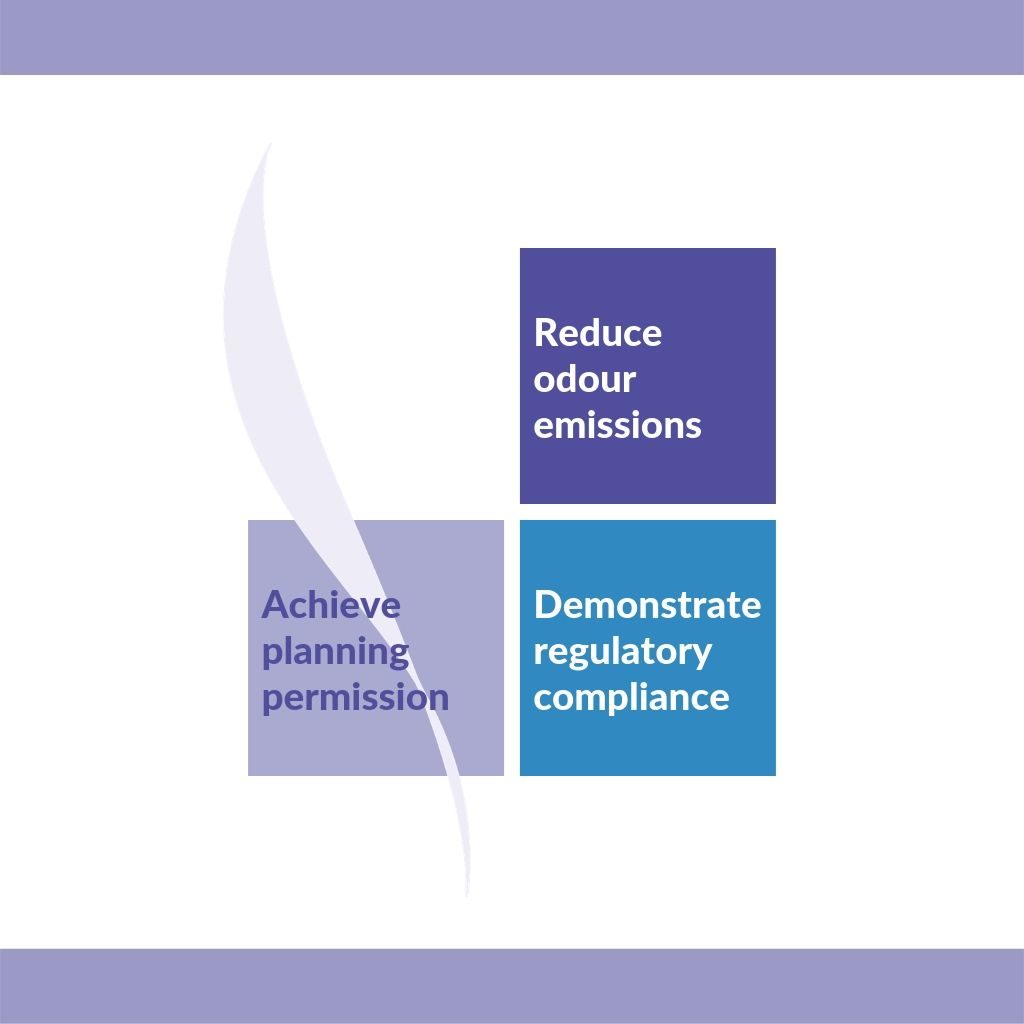Key Objectives for Odour Management Clients

Odour Management Services: Client Outcomes
Often, clients come to us as an odour management consultancy because you’ve been advised to do so. Usually that referral comes from a regulator or local authority, relating to a regulatory or planning stipulation. So your initial experience with these services may not always be the most welcome.
This article looks at your potential outcomes from a different angle. What are your key objectives? What do the benefits look like? In general, there are three core reasons our clients need support with odour management activities.
They are to:
✔ Reduce Odour Emissions
✔ Demonstrate Regulatory Compliance
✔ Achieve Planning Permission
These objectives are not mutually exclusive!

Reduce Odour Emissions
Unsurprisingly, many clients want to reduce emissions from their processes. Nowadays, society has high expectations of operators. People expect to live and work in an environment that is odour free. Not only that, but environmental permits are in place to ensure this happens. So if you start to receive complaints, you’ll need to react quickly and fix the problem. It’s even better if you can catch potential odour management issues before they escalate.
Develop Best Practices – Futureproof Your Processes
It’s an ongoing process to reduce and maintain low odour emissions. Continual best practice can save your business time, effort and money later. Not to mention good feeling in your community.
An odour emission survey, sniff survey or dispersion model (or a combination of the three) arms you with statistical data. This data helps you understand the sources and extent of emissions from your industrial processes.
In turn, you can use this knowledge to make changes. It will also help you to maintain or build odour management best practice procedures. This will also lead to efficiency and maintenance improvements. What’s more, robust practices give you a paper trail for use as evidence in court or for the regulator if needed later.
These factors contribute to ‘futureproofing’ your processes, ensuring their operational longevity.
Ensure Effective Odour Abatement & Management Design
Odour management data is useful if you’re planning to build a new site or install new abatement equipment. Usually this will involve an odour sampling survey or a sniff survey, combined with dispersion modelling. The results will tell you the projected impact of your planned site on the local community. When you know this at an early stage you can resolve potential issues before you’ve committed to the build process. Inevitably this saves money and energy later on. We offer invaluable advice when it comes to designing with odour mitigation in mind.
Demonstrate Regulatory Compliance
Clients with this objective tend to approach us from two very specific angles.
Firstly, you may have received complaints. In this case you need evidence to prove or disprove those complaints. This may or may not be driven by the regulator.
Secondly, you may recognise the benefits of being proactive! Can you demonstrate an ongoing record of best practice in your odour management? There are many reasons why this approach is a good idea.
Prove or Disprove Odour Complaints
By their nature, complaints are very subjective. But that doesn’t mean they shouldn’t be taken seriously. Even a single complaint can indicate a greater issue, which you may not be aware of as the operator. The permitting authority will respond to complaints in a number of ways in order to validate them. This can include requesting odour logs from complainants, site visits and field monitoring. They may also ask you to show an effective odour management plan is in operation.
You can improve your understanding of your emissions in a number of ways. An odour sampling survey and sniff survey will give you a good analysis of your processes performance. Dispersion modelling can help provide a full picture of the impact on the surrounding area. Data from these services will show whether complaints are justified or not. You can also use it to demonstrate an effective response, both for the permitting authority and in extreme cases, in court. What’s more, you can use the data to improve your odour management plan even further.
Demonstrate Best Practice with Your Odour Management Plan
A real commitment to minimising your impact in your locality is very important. It helps your sites co-exist comfortably with the people around you. Not only that, but it shows the regulator you’re serious about complying with your environmental permits. The simplest way to demonstrate this commitment is to have an effective odour management plan in operation. It allows you to identify issues before they escalate and shows your commitment to good odour management. This can be very helpful for you in mitigating potential sanctions from unforeseen contraventions.
Achieve Planning Permission
Planning officers often demand evidence of the potential impact of odours relating to new housing and commercial developments. In the simplest terms – if you don’t have a suitable odour assessment survey, you won’t get planning permission. So it’s extremely important to make sure you tick the right boxes.
Demonstrate Compliance with Planning Restrictions
The service you need will, unsurprisingly, depend on the type of development you’re working on. For smaller projects an odour assessment survey will suffice. It’s a qualitative assessment which assesses the impact of a proposed development. This is useful for small housing developments, single commercial properties, or changes to an existing commercial property.
For larger developments, you may need more detailed services to help understand the potential impact. This could be a sniff survey, odour sampling survey and/or dispersion modelling. Our team will discuss the specifics of your project and advise on the best approach.
Conducting appropriate odour assessments will deliver two outcomes. First, it will help you achieve planning permission. Second, it will help you demonstrate your compliance with your planning permits on an ongoing basis. To reiterate, you should ensure you have an effective odour management plan in place at all times.
Take Action If Not!
Demonstrating the potential impact of odour emissions is, frankly, sometimes just another hoop to jump through. We understand it can be frustrating and adds yet more complexity to the application process. However, when it highlights unexpected problems it can be invaluable. In this case, you have the knowledge needed to make changes. This can potentially save you time, effort and money further down the line. And of course, it can be the difference between securing planning permission and not!
Useful References
Environment Agency
Additional guidance for H4 Odour Management – how to comply with your environmental permit
Institute of Air Quality Management (IAQM)
Guidance on the assessment of odour for planning
Odour Study Day
Attend the Odour Study Day training course to learn more about about all aspects of odour management. The course is CPD certified, accredited by CIWEM and endorsed by the IAQM. Places fill up fast so book early to avoid disappointment.
Achieve Your Odour Management Objectives
In all likelihood, we’ve covered some of the specifics of your odour challenges in this article. If that’s the case, please get in touch. Our odour experts are happy to explain more about how our services can help you. On the other hand, there are always exceptions to the rule! If you’ve got a more specific challenge we can help you with, we’d love to hear from you. Give us a call on 01525 351396 or contact us here.

